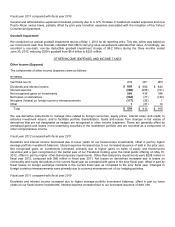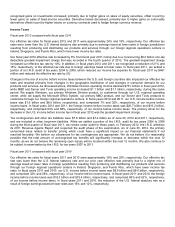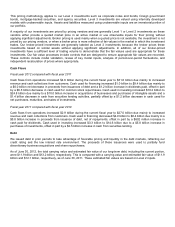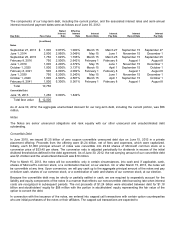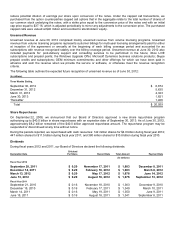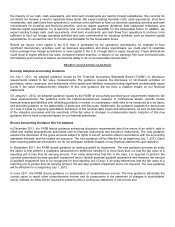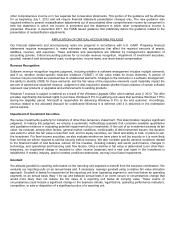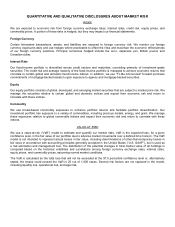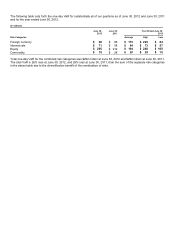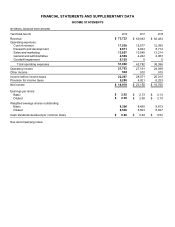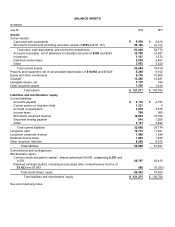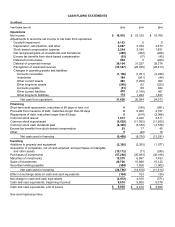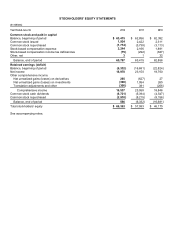Microsoft 2012 Annual Report Download - page 36
Download and view the complete annual report
Please find page 36 of the 2012 Microsoft annual report below. You can navigate through the pages in the report by either clicking on the pages listed below, or by using the keyword search tool below to find specific information within the annual report.
other comprehensive income or in two separate but consecutive statements. This portion of the guidance will be effective
for us beginning July 1, 2012 and will require financial statement presentation changes only. The new guidance also
required entities to present reclassification adjustments out of accumulated other comprehensive income by component in
both the statement in which net income is presented and the statement in which other comprehensive income is
presented. However, in December 2011, the FASB issued guidance that indefinitely defers the guidance related to the
presentation of reclassification adjustments.
APPLICATION OF CRITICAL ACCOUNTING POLICIES
Our financial statements and accompanying notes are prepared in accordance with U.S. GAAP. Preparing financial
statements requires management to make estimates and assumptions that affect the reported amounts of assets,
liabilities, revenue, and expenses. These estimates and assumptions are affected by management’s application of
accounting policies. Critical accounting policies for us include revenue recognition, impairment of investment securities,
goodwill, research and development costs, contingencies, income taxes, and stock-based compensation.
Revenue Recognition
Software revenue recognition requires judgment, including whether a software arrangement includes multiple elements,
and if so, whether vendor-specific objective evidence (“VSOE”) of fair value exists for those elements. A portion of
revenue may be recorded as unearned due to undelivered elements. Changes to the elements in a software arrangement,
the ability to identify VSOE for those elements, and the fair value of the respective elements could materially impact the
amount of earned and unearned revenue. Judgment is also required to assess whether future releases of certain software
represent new products or upgrades and enhancements to existing products.
Windows 7 revenue is subject to deferral as a result of the Windows Upgrade Offer, which started June 2, 2012. The offer
provides significantly discounted rights to purchase Windows 8 Pro to qualifying end users that purchase Windows 7 PCs
during the eligibility period. Microsoft is responsible for delivering Windows 8 Pro to the end customer. Accordingly,
revenue related to the allocated discount for undelivered Windows 8 is deferred until it is delivered or the redemption
period expires.
Impairment of Investment Securities
We review investments quarterly for indicators of other-than-temporary impairment. This determination requires significant
judgment. In making this judgment, we employ a systematic methodology quarterly that considers available quantitative
and qualitative evidence in evaluating potential impairment of our investments. If the cost of an investment exceeds its fair
value, we evaluate, among other factors, general market conditions, credit quality of debt instrument issuers, the duration
and extent to which the fair value is less than cost, and for equity securities, our intent and ability to hold, or plans to sell,
the investment. For fixed-income securities, we also evaluate whether we have plans to sell the security or it is more likely
than not that we will be required to sell the security before recovery. We also consider specific adverse conditions related
to the financial health of and business outlook for the investee, including industry and sector performance, changes in
technology, and operational and financing cash flow factors. Once a decline in fair value is determined to be other-than-
temporary, an impairment charge is recorded to other income (expense) and a new cost basis in the investment is
established. If market, industry, and/or investee conditions deteriorate, we may incur future impairments.
Goodwill
We allocate goodwill to reporting units based on the reporting unit expected to benefit from the business combination. We
evaluate our reporting units on an annual basis and, if necessary, reassign goodwill using a relative fair value allocation
approach. Goodwill is tested for impairment at the reporting unit level (operating segment or one level below an operating
segment) on an annual basis (May 1 for us) and between annual tests if an event occurs or circumstances change that
would more likely than not reduce the fair value of a reporting unit below its carrying value. These events or
circumstances could include a significant change in the business climate, legal factors, operating performance indicators,
competition, or sale or disposition of a significant portion of a reporting unit.




